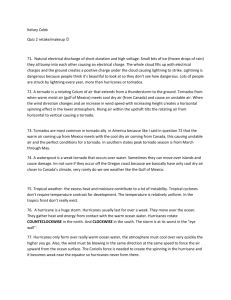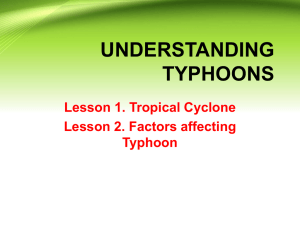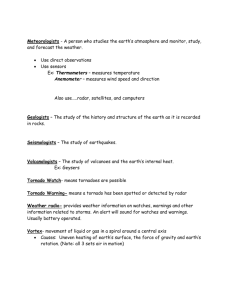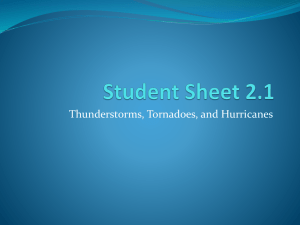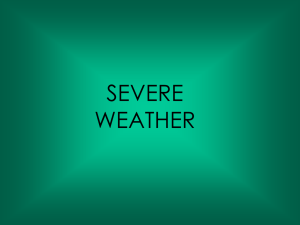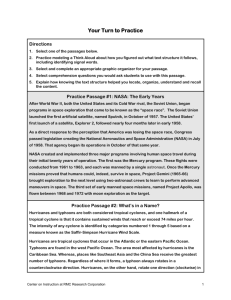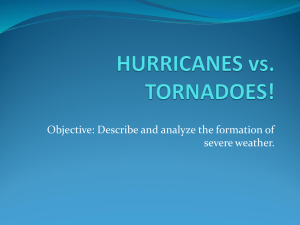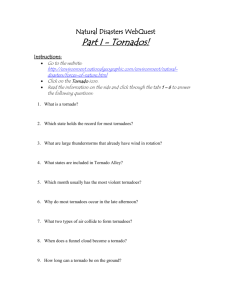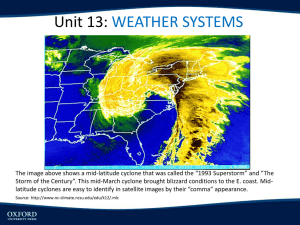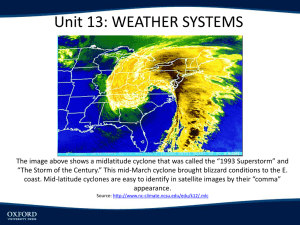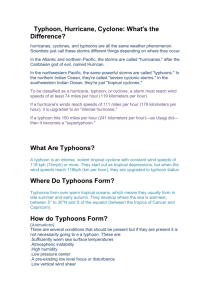WEATHER DISTURBANCE - NATSCI-A7
advertisement
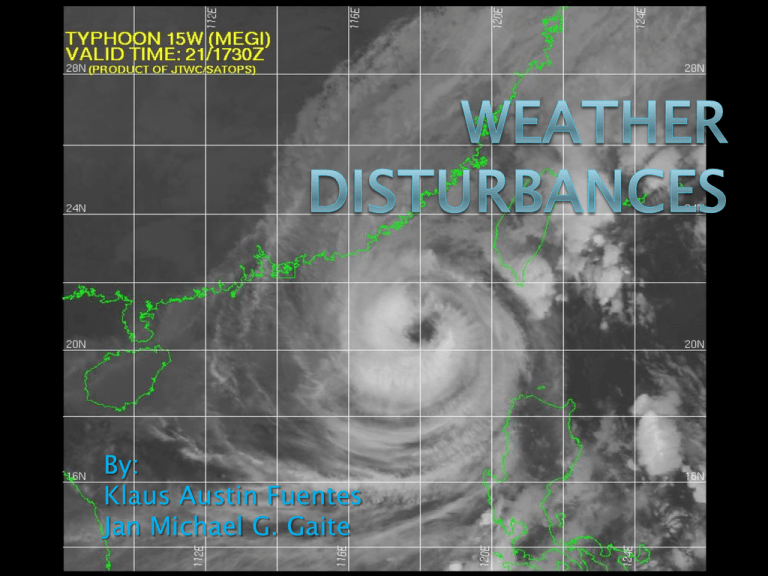
By: Klaus Austin Fuentes Jan Michael G. Gaite WEATHER DISTURBANCE TYPES OF WEATHER DIS T U RBANCES Typhoon/Hurricane Tropical Cyclones Tornado Typhoon/Hurricane - A large heat engine, where great amounts of heat are being produced from the process of latent heat of condensation. - occurs as water vapor is being evaporated from the ocean surface and condensed into cloud droplets. Typhoon/Hurricane - Both are names of tropical storms and most of their characteristics are the same. They have wind speeds that are more than 74 mph, and are accompanied by hail, strong winds, storm surges and rain. - Firstly, tropical storms are classified by the region in which they originate. Hurricane versus Typhoons Hurricane comes from the word Huracan which means ‘big wind’. It was originally a term used by the Native Americans for storms that originated in the West Atlantic. Typhoon is derived from the Chinese Tai Fun which means ‘great wind’ and referred to winds that developed in the North Pacific Hurricane versus Typhoons Hurricane develops in the Western Atlantic Ocean where the water temperature is colder. Hurricanes develop in the Western Atlantic Ocean during summer. Typhoons develop in the Pacific Ocean where the water is warmer. Tropical storm develops where the water is warm and the place is humid. That is why it is said that typhoons are stronger than hurricanes. Hurricane versus Typhoons Hurricanes damage more land areas than Typhoons, which cause damage to countries’ coastlines. Hurricanes occur during October in the Western Atlantic Ocean (cold region) Hurricanes move both clockwise and counter clockwise Typhoons are said to be stronger than Hurricanes because it develops where water is warm. Typhoons appear during the months of July to November in the Northern Pacific Ocean (warm and humid region). Typhoons move clockwise Causes of typhoon/hurricane: Pre-existing disturbance Warm ocean water Low atmospheric stability Sufficient Coriolis force Low vertical wind shear Upper atmosphere divergence * Coriolis force - an apparent force that as a result of the earth’s rotation deflects moving objects to the right in the northern hemisphere and to the left in the southern hemisphere. Tropical Cyclones - a storm system characterized by a lowpressure center and numerous thundersto rms that produce strong winds and heavy rain. Causes of tropical cyclones: Water temperatures of at least 26.5 °C (79.7 °F) Rapid cooling with height High humidity Low amounts of wind shear A need to form more than 555 km (345 mi) or 5 degrees of latitude away from the equator pre-existing system of disturbed weather Tornado - rotating columns of air usually produced by severe thunderstorms. Multi vortex tornadoes – mini tornadoes circulating around a larger one. WATERSPOUT - tornadoes form over water. LANDSPOUT - tornadoes form over land. How tornadoes are formed? - most tornadoes actually form from the ground up. It is simply highly saturated air dropping from the thunderstorm which gives the appearance of a tornado “touching down”. How fast do tornadoes move? - a tornado on average moves at speeds of 30mph, but can range stationary to about 70mph. Tornado versus Cylone Land encourages the development of a tornado, while it destroys the cyclone’s formation. The time frame from the birth of a tornado until it dies out, is generally measured in minutes Tornado damage is intense and targeted The tornado cannot encourage the development of the cyclone. Cyclones develop and fester over the oceans. The cyclone has a longer life span. The time frame from the birth to the death of a cyclone, is measured in hours and days. Cyclone damage is widespread, and the exposure to the elements is longer. The cyclone can encourage the development of the tornado once landfall is achieved. References: http://www.pagasa.dost.gov.ph/ http://www.weather.unisys.com/ http://www.differencebetween.net/s cience/nature/difference-betweenhurricane-and-typhoon/
